Did you know that you don’t really need to buy green paint? Paint color mixing is so easy and is a great way to see just exactly how many colors you actually have. Color mixing is gonna rock your world, my friend, and I’m going to show you a super simple way to keep track of all of your paint mixtures.
In This Article...
- Before We Begin
- General Instructions for Each Color Mixing Combo
- Paint Color Mixing Recipe #1
- Paint Color Mixing Recipe #2
- Paint Color Mixing Recipe #3
- Paint Color Mixing Recipe #4
- Color Mixing with Complementary Colors
- Complementary Color Mixing Chart #1
- Complimentary Color Mixing Chart #2
- Complimentary Color Mixing Chart #3
- Complimentary Color Mixing Chart #4
Before We Begin
What I’m about to show you is just a starting point. Believe me, you can keep finding a ton of color mixing combos that make green paint. This is great news because you can save yourself some serious moola in the future! Yes, we’ll be making four different greens but then we’ll be mixing other paint colors into those greens to make even more shades!
WHAT YOU’LL NEED:
- Paper (I just used regular printer paper)
- A couple of jars of water
- Paper towel and an old rag
- A paintbrush (I like using a ¾” flat or angle brush)
- A palette knife (or an old credit card, butter knife, etc.)
- A palette (or paper plate) to mix your paint on (you’ll need to be prepared to clean a palette multiple times or use multiple paper plates)
- Paint:
- Cadmium Yellow Medium Hue (or any sunny yellow)
- Yellow Ochre (or any straw yellow)
- Ultramarine Blue (or any royal blue)
- Phthalo Blue (or any warm blue that leans toward green)
- Diox Purple (or any deep plum)
- Cadmium Red Light Hue (or any pumpkin orange)
- Cadmium Red Medium Hue (or any bright red that doesn’t lean too cherry and doesn’t lean too barn colored)
- Titanium white
- Mars black
NOTE:
- All of the paints I used were Liquitex Basics but you can use whatever paints you have
- I painted black lines first so that I could keep track of the transparency and opacity of the paint mixtures. You don’t have to do this but it does help to prepare you for how many coats you’ll need to consider to cover a project
- Master recipe refers to the base colors mixed together to make the four green paint colors
If you want to experiment and come up with even more shades of green, create a mixture with your master recipe where one color is twice the amount as the other (ratio of 1:2).
General Instructions for Each Color Mixing Combo
This is the process you’ll be using every time you make a new green master recipe. It’s an exercise that is great to do on a day when you just want to relax and play with color.
- Mix your two colors (1:1) to create a green and divide your mixture in two (make sure to label everything so you have it for future reference)
- Paint a strip at the beginning of your first and second black line (if you don’t have black lines, just paint a strip on the left-hand side of your paper so you have lots of room for more color mixing
- Add a small amount of white to one part of the master recipe and paint a strip along the first black line (or next to your first master recipe strip)
- Continue to add small amounts of white paint to the one part of the master recipe so it gets lighter and lighter
- With each addition of white, paint a strip (save your lightest green paint mixture to use in a little bit!)
- Once you’re finished with your white, rinse and dry your brush well so there is no white in the bristles
- In the other part of your master recipe, add a teeny tiny bit of black and paint a strip along the lower black line
- Continue adding a bit of black, and paint strips, two more times and clean out your brush
- On the bottom line, after you’ve painted the green/black mixture, add just a bit of black to your lightest green mixture (this would be the color that you ended with on the top line), and paint a strip
- Continue adding a small amount of black, to the light green mixture, three more times
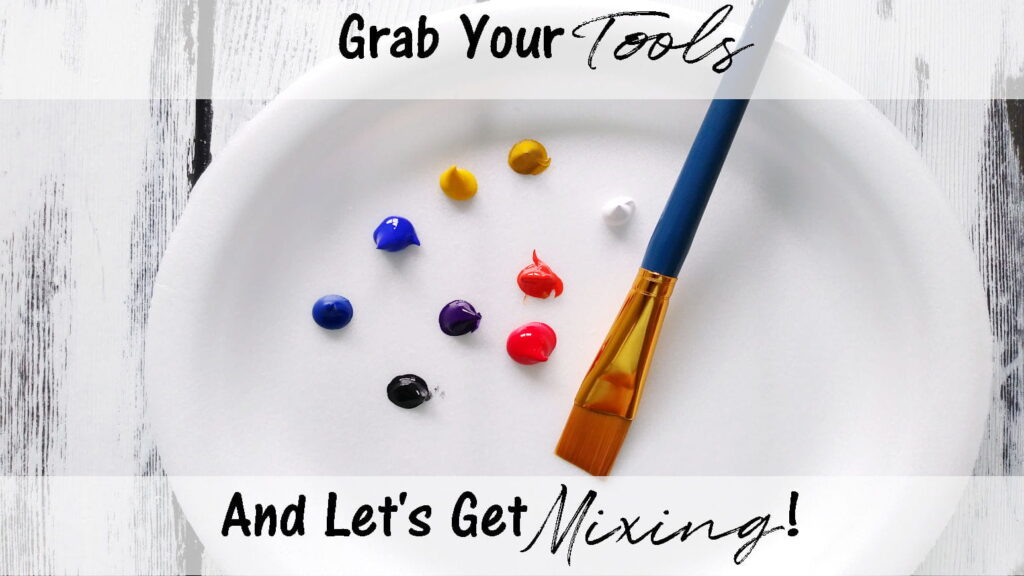
We all know that yellow and blue make green, right? But, if you have a couple of different yellows or blues (or both), you can make so many different shades of green that you’ll never have to buy a single tube of green paint from the store again! Okay, ready? And, awayyyyy we gooooo!
Paint Color Mixing Recipe #1
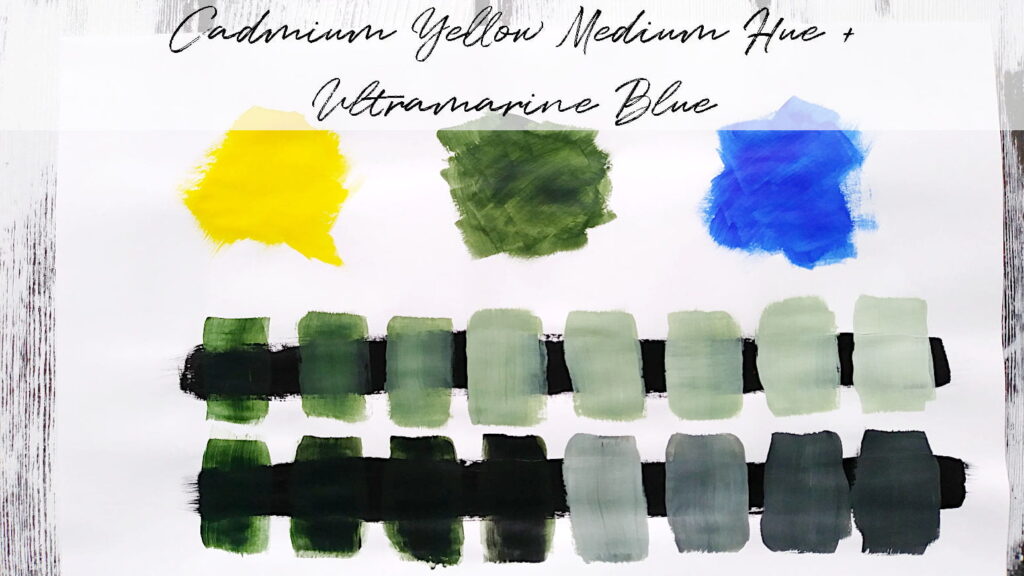
For our first master recipe, we’re going to use an equal amount of Cadmium Yellow Medium Hue and Ultramarine Blue. Once you’re finished color mixing and making your color chips, let’s take a good look and make some notes:
- Both base colors are transparent so they take a bit more finagling to make them more opaque
- On its own, this color mixing combo creates a very deep dark green
- Because it’s such a dark green, it doesn’t take much black to deepen it
- I think this set of paint mixtures would be great for painting an evergreen forest or a study piece of herbs and spices
Paint Color Mixing Recipe #2
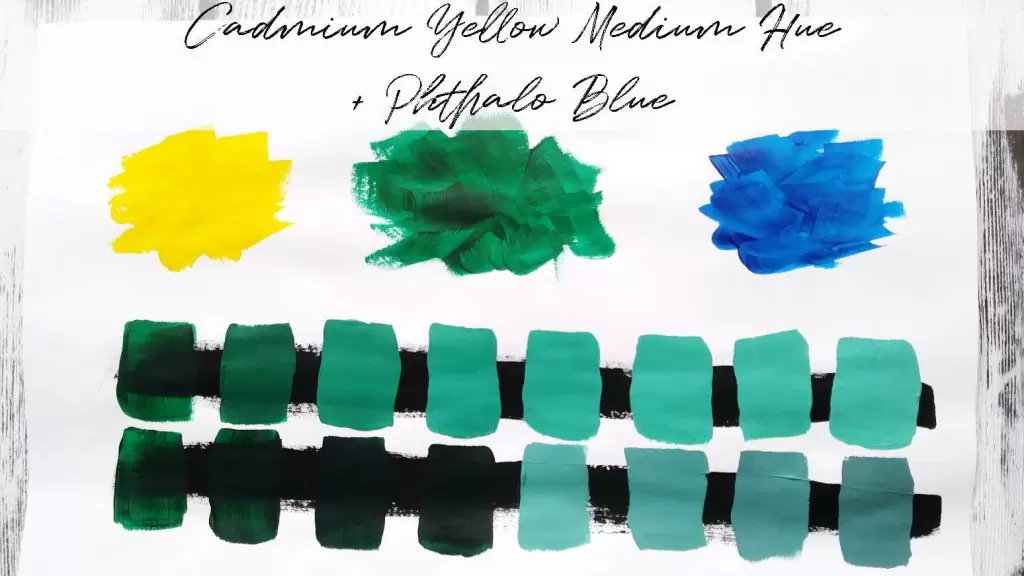
For this master recipe, let’s mix equal parts of Cadmium Yellow Medium Hue (or a sunny yellow of your choice) and Phthalo Blue (or a blue that leans toward green). Follow the general instructions given above and let dry. What do you notice? What’s the coverage like? What projects would this set of green paint mixtures working best? Record your notes so you’ll remember!
My Personal Notes:
- Brighter than the Cad. Yellow/Ultramarine combination
- Seems to have a bit better coverage
- Would be the perfect color mixing set to use for an ocean painting
Paint Color Mixing Recipe #3
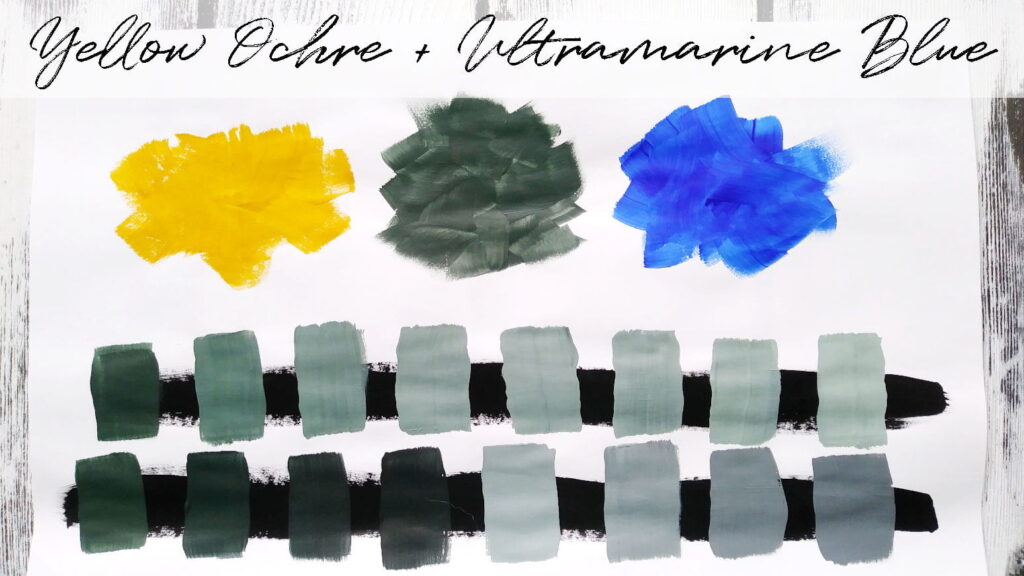
Now, let’s mix up equal parts of Yellow Ochre (or a straw color) and Ultramarine Blue (or a royal blue). Again, follow the general instructions to create your color mixing chart. Once dry, write down your observations.
My Observations:
- This mixture creates more earthy greens
- Good coverage
- Great for a misty forest landscape
Paint Color Mixing Recipe #4
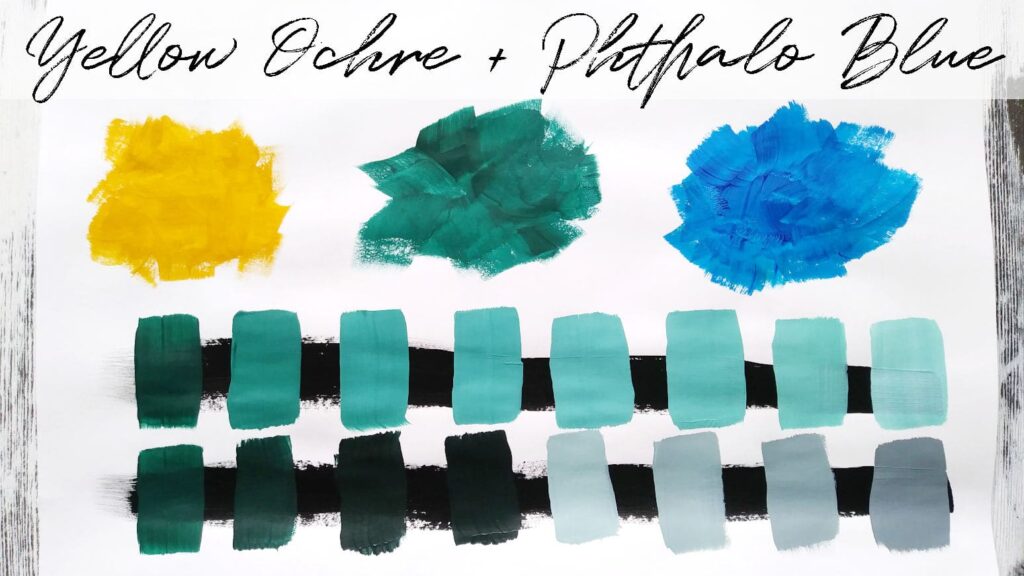
For our last master recipe mixture, we’re going to combine Yellow Ochre and Phthalo Blue, in equal amounts, and record our observations for future painting projects.
What I Noticed:
- Brighter than ochre and ultramarine but not as vibrant as cad yellow medium and phthalo blue mixture
- Good coverage
- Would work well for a painting of a tropical ocean under a cloudy sky
Color Mixing with Complementary Colors
Complementary colors are colors that lie opposite to each other on the color wheel. I typically use these when I want to tone something down. I found a couple of free color wheels that you can print off here.
For example, let’s say that I’ve painted a tree with green leaves but the only green I have is a lime color and that’s way too bright for what I’m trying to achieve. Well, if you look on a color wheel, you’ll see that red is opposite to green. So, if I start adding red, a little at a time, I’ll be able to tone down that lime green into something more appropriate for a realistic tree.
For our color mixing charts, we are going to use three different complementary colors and see how many greens we can come up with. For this exercise, we’ll be using Diox Purple (or a vibrant plum), Cadmium Red Light Hue (or a pumpkin orange), and Cadmium Red Medium Hue (or a bright true red).
INSTRUCTIONS:
- Paint three black lines on a sheet of paper
- Grab a clean palette or plate
- Mix one of the above green master recipes (makes sure you make enough for three complementary colors plus extra
- Split off some of your green master recipe and mix it with an equal part of purple
- Paint a strip at the beginning of your first black line
- Add some white to your new master recipe/complementary color combo and paint a strip
- Continue the above step, adding more white as you go, two more times
- Next, mix some of your master recipe green with the lightest color you ended up with in the step above, and paint a strip
- Continue the above step, adding more of your green master recipe as you go, three more times
- On the next black line, follow the above directions but use orange instead of purple
- On the bottom black line, repeat the process but use red instead of orange
- Make sure to label all of the colors and takes notes of your observations as well as ideas on what you could use the new color mixes for in a future project
Congrats, you’ve just completed one of your complementary color mixing charts. Continue using the instructions until you have a complementary chart for each of the four master recipes that we used to make green.
Complementary Color Mixing Chart #1
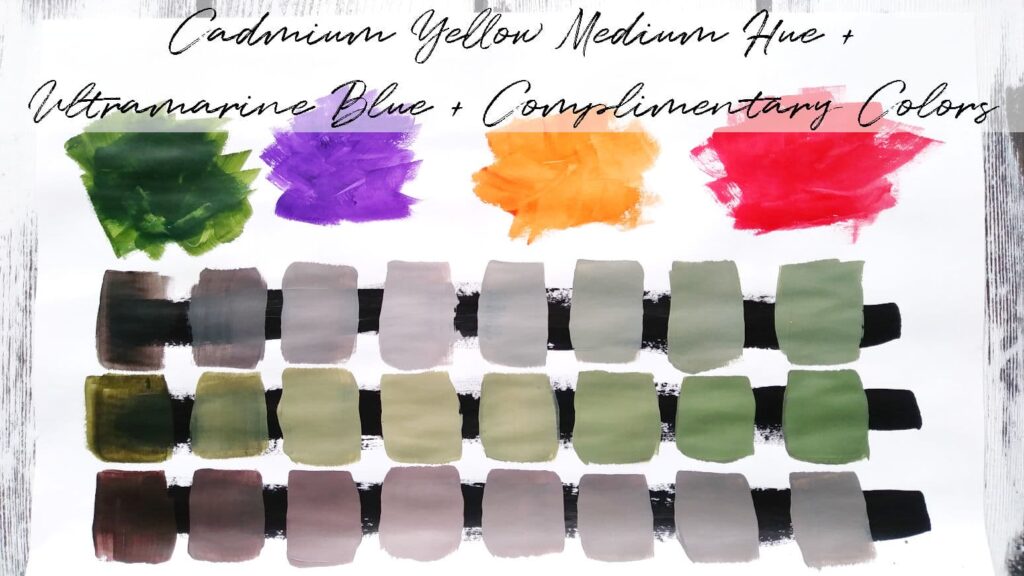
For the first color mixing chart, I used Cadmium Yellow Medium Hue and Ultramarine Blue to make green. Then I added my complementary colors to the base master recipe.
My Notes:
- Purple creates a beautiful chocolate brown, lightens to a taupe and then olive green
- Adding orange starts as a deep olive color that morphs to a cooler green
- Red begins as a reddish-brown but ends as a cooler brown
As you can see from my notes, some surprising things happened! I’m in love with the chocolate brown I made from mixing purple with the master recipe. And, the red never did get back to green. I mean, I’m sure it would if you added enough of your master color but it’s cool that you end up with a completely different color!
Complimentary Color Mixing Chart #2
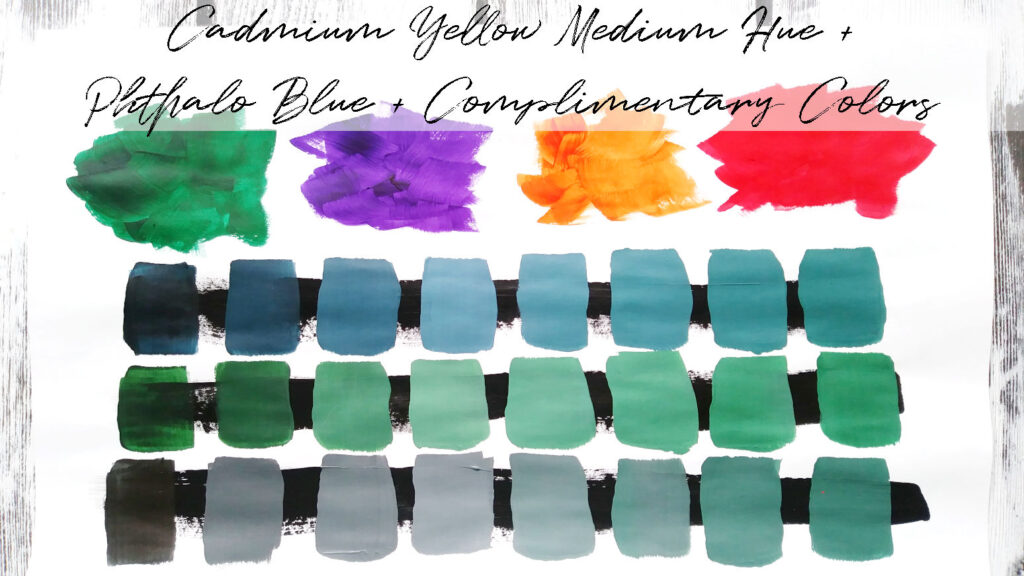
The above color mixing chart was created by mixing complementary colors with Cadmium Yellow Medium Hue and Phthalo Blue.
My Observations:
- Purple creates a deep midnight blue
- Red makes a rich black
Holy moly! The deep midnight blue is such a useful color! You could use it for, of course, a night sky or even deep ocean paintings.
And, the red making black! Okay, so, you’re going to hear a lot about how you shouldn’t use black straight out of the tube to paint your subject matter. The reason people say this is because black can look a bit flat. I don’t 100% agree with this (who doesn’t love a black and white painting with a pop of bright color!) but I do agree that having black with an undertone can give dimension to a painting.
Complimentary Color Mixing Chart #3
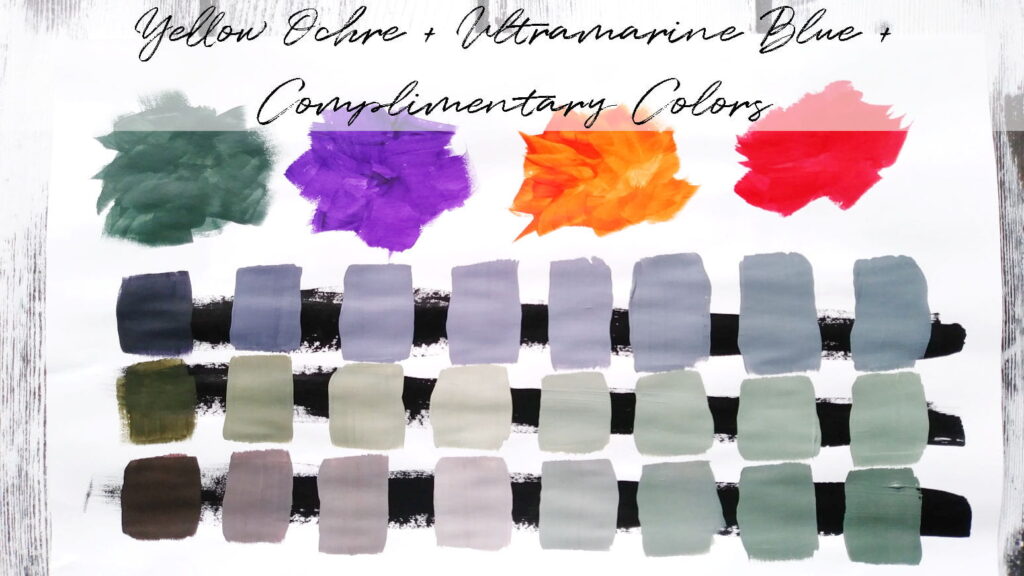
This color mixing chart was made with the Yellow Ochre and Ultramarine Blue master recipe.
Notes:
- Creates blacks, browns, greys, and muted greens
- Would be a great color combo for painting a dimly lit forest path
You could create a whole painting from just this color mixing combination! The first thing that came to my mind was walking through a deep forest, on a grey drizzly day, on a dimly lit path. Wouldn’t that make a dramatic piece of art?!
Complimentary Color Mixing Chart #4
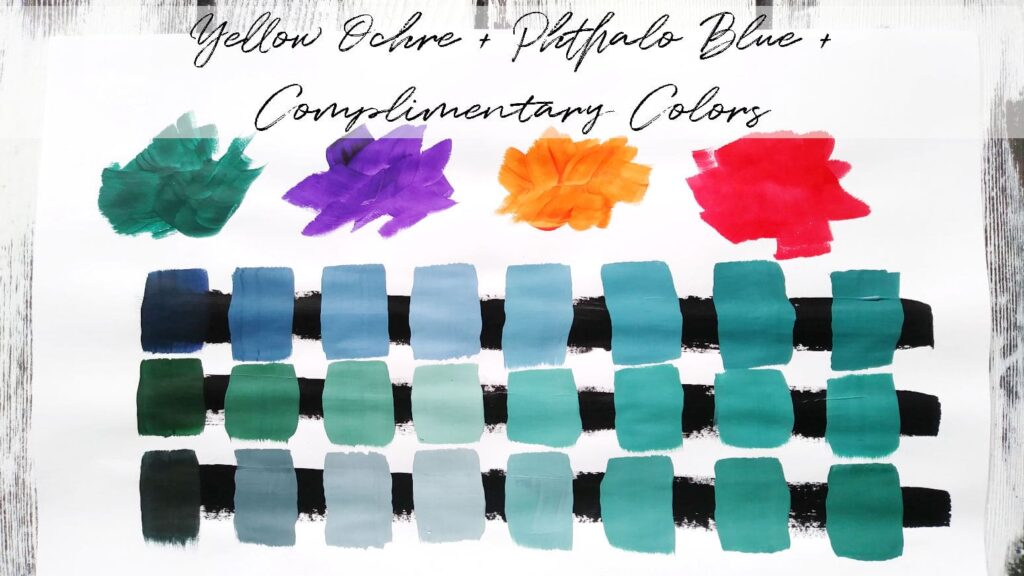
In the last color mixing chart, I used Yellow Ochre and Phthalo Blue as the master recipe.
Of Interest:
- Much easier to pull back toward green than the yellow ochre/ultramarine blue recipe
- Mixed with purple, makes a beautiful dark blue but not as dark as the cad. Yellow/phthalo blue/purple mixture
I’m pretty sure that it was easier to get back to green with this particular color mixing recipe because the phthalo blue that I used leans more toward green.
You really don’t need to spend your money buying every shade of green on the shelf. Experiment with what you already have and see what happens when you mix different colors together.
The amount of different shades of green that you can make on your own is huge and we’ve only scratched the surface here!
Consider making these color mixing charts every time you buy a new color and keep them all together in a binder. The next time you’re looking at a reference photo you can try to find the colors you need using paint you already have.
If you want to try out your new green paint colors, check out my pine tree article here or my painting grass practice here.
Related Articles:
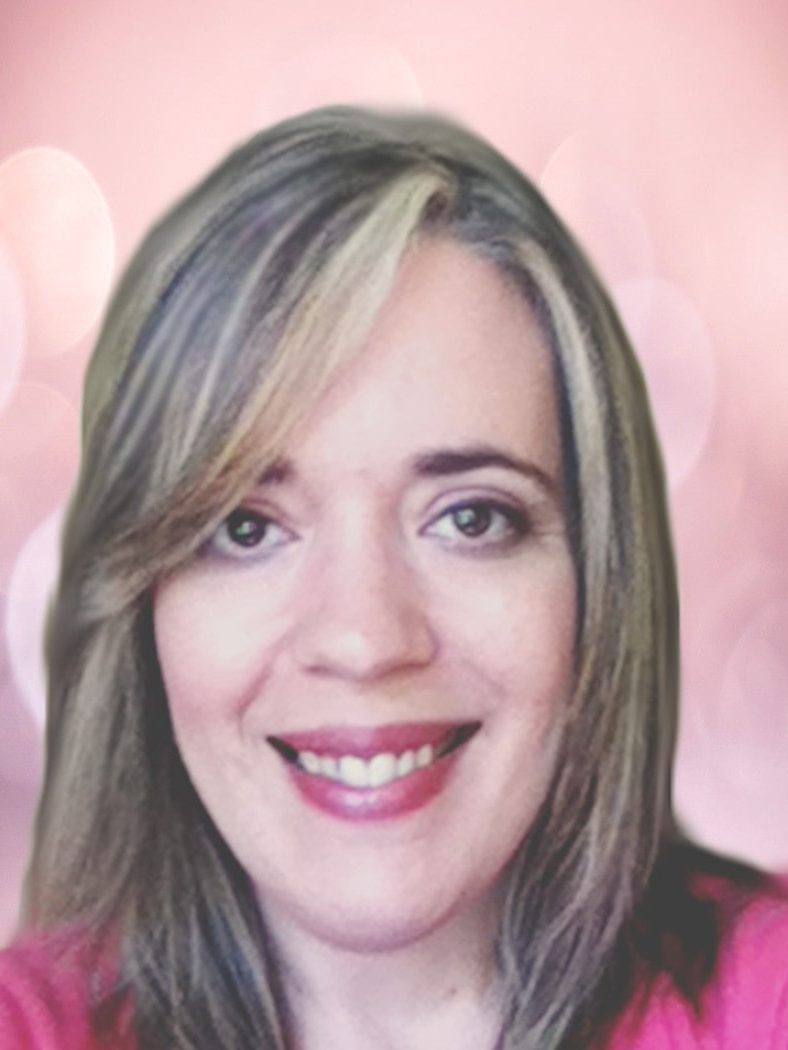
Meet Sara, a seasoned veteran in the world of art. With a knack for mixing paints to unveil breathtaking new hues, she’s adorned countless commissions and independently captivated art enthusiasts with her creations. Having spent over a decade immersed in the realm of art gallery management, Sara’s insight into the intricacies of the art scene shines through her work.
But don’t let her impressive résumé fool you – Sara’s approach to art is as lively as her palette. Known for her wit and humor, she infuses her passion for painting with a playful spirit, making every stroke a delightful adventure. As a dedicated mentor, she’s committed to guiding her fellow artists towards success, always staying ahead of the curve with the latest techniques and trends.

comment arriver à un beau vert sauge ….Après 3 essais